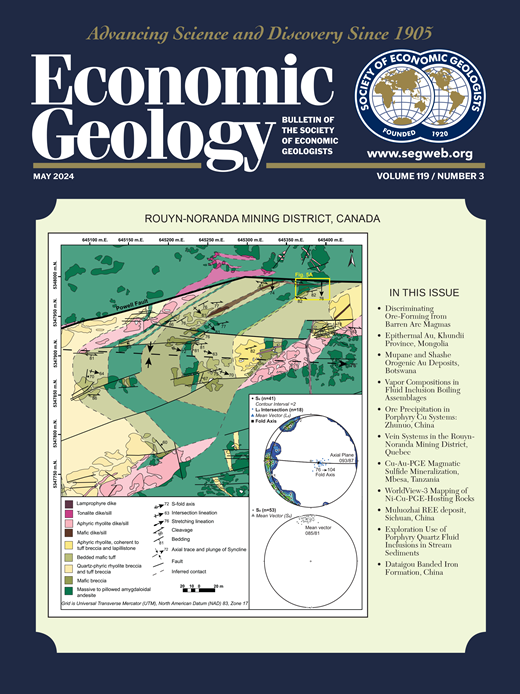西澳大利亚锂伟晶岩矿石的矿物结构特征
IF 4.9
1区 地球科学
Q1 GEOCHEMISTRY & GEOPHYSICS
引用次数: 0
摘要
对西澳大利亚太古代Yilgarn和Pilbara克拉通中主要的锂-铯-钽(LCT)辉晶岩侵入体进行了矿物学和地球化学表征,以建立区分这些重要锂离子电池资源的关键参数。西澳大利亚大部分伟晶岩属于以下三种主要杂岩亚型之一:(1)锂辉石- greenbushes, Kathleen Valley, Dome North, Mount Marion;(2) petalite-Londonderry, Dome North;(3)锂云母-辛克莱铯。较不常见的伟晶岩类型包括Mount catlin、Bald Hill和Pilgangoora(钠长辉石型)和Dalgaranga伟晶岩(钠长辉石型)。锂辉石具有接近化学计量的LiAlSi2O6组成,Li2O含量为~8.0 wt %。具有商业重要性的杂质,铁(+ Mn)变化高达1 - 1.2 wt %,钠(500 - 1200 ppm)是在锂辉石中检测到的唯一其他重要微量元素。辉石结构中M2位点上Li的结构缺陷导致锂辉石易受蚀变的影响,并且在结晶过程中,相对于Al和Si, Li优先被去除,含水蚀变导致Li含量降低到5.50 ~ 5.84 wt % Li2O。锂辉石普遍受到两种主要蚀变的影响:一种不常见的、结晶后的、假晶型的锂辉石被块状的、深绿色到黑色的、细粒的、含锂的云母绿泥石(库克岩)组合(卡特林山和博尔德山伟晶岩)取代;以及更广泛的蚀变,其特征是在与Na/ k长石接触的锂辉石晶体边缘,呈现出图形织构、锂辉石-石英共生(SQUI)的复合组合。与前一种蚀变类型相关的是一种普遍的次生绢云母样脉蚀变,沿锂辉石内部裂缝和解理面发育。在所有情况下,蚀变导致锂辉石中Li的损失,并且,与伪晶替换和脉蚀变相关,引入了大量的K和较少的微量元素杂质,如F, Mn, Fe, Mg和Rb。矿物-结构组合表明,在Dome北矿床上部的花瓣岩带和在Greenbushes伟晶岩的Li带中分别发育了一个结构更粗糙但不相关的SQUI,这些伟晶岩分别由前花瓣岩(已证实)和virgilite(推断)分解形成。云母(白云母和云母)组成变化与Li wt %呈良好相关,与F wt %呈正相关,Al/Si与Li含量呈负相关。西澳大利亚和全球伟晶岩中云母的K、Rb和Cs组成系统表明,在伟晶岩的结晶过程中,可能存在着简单的瑞利分选不能解释的复杂分选机制。Greenbushes伟晶岩的锆石U-Pb年龄为2631±4 Ma,比先前确定的2527 Ma年龄更老,表明Greenbushes伟晶岩的侵位与伊尔甘克拉通的其他伟晶岩是同时期的,最大年龄范围约为2650 ~ 2620 Ma。据报道,Pilbara克拉通伟晶岩(如Wodgina和Pilgangoora)中Ta-Nb-Sn氧化物的Pb-Pb定年确定了一个2850 - 2830 Ma的侵位窗口,表明这些伟晶岩明显比Yilgarn克拉通伟晶岩更古老(约200 m.y)。皮尔甘古拉(Pilgangoora)玄武岩的U-Pb年龄较年轻(2629±13 Ma),与皮尔巴拉(Pilbara)克拉顿玄武岩的中太古代年龄相冲突,这是由于区域变形和变质作用导致的Pb损失,使锆石的同位素年龄更年轻。进一步的年代学研究有助于建立皮尔巴拉克拉通伟晶岩结晶的区域性、时代性框架。本文章由计算机程序翻译,如有差异,请以英文原文为准。
Mineral-Textural Characteristics of Lithium Pegmatite Ores of Western Australia
Mineralogical and geochemical characterization of some of the main lithium-cesium-tantalum (LCT) pegmatite intrusions of the Archaean Yilgarn and Pilbara cratons, Western Australia, was undertaken to establish the key parameters that distinguish these important Li-ion battery resources. The majority of Western Australia pegmatites investigated belong to one of three main complex subtypes: (1) spodumene—Greenbushes, Kathleen Valley, Dome North, Mount Marion; (2) petalite—Londonderry, Dome North; and (3) lepidolite—Sinclair cesium. Examples of less common pegmatite types included Mount Cattlin, Bald Hill, and Pilgangoora (albite-spodumene type) and the Dalgaranga pegmatite (albite type). Spodumene shows a near-stoichiometric LiAlSi2O6 composition with a Li2O content of ~8.0 wt %. Impurities of commercial importance, Fe (+ Mn) varied up to 1 to 1.2 wt % with Na (500–1,200 ppm), as the only other trace element of significance detected in spodumene. Structural deficiencies of Li on the M2 site in the pyroxene structure contribute to the susceptibility of spodumene to alteration and to the preferential removal of Li, relative to Al and Si, during postcrystallization, and hydrous alteration resulting in reduced Li contents of 5.50 to 5.84 wt % Li2O. Spodumene is universally affected by two key types of alteration: a less common, postcrystallization, pseudomorphic replacement of spodumene by a massive, dark-green-to-black, fine-grained, Li-bearing mica-chlorite (cookeite) assemblage (Mount Cattlin and Bald Hill pegmatites); and a more widespread alteration characterized by symplectitic assemblages of graphic-textured, spodumene-quartz intergrowth (SQUI) along the crystal margins of spodumene in contact with Na/K-feldspar. Related to the former alteration style is a pervasive, secondary sericite-like vein alteration, developed along internal fractures and cleavage planes of spodumene. In all cases, alteration leads to the loss of Li from spodumene, and, in relation to the pseudomorphic replacement and vein alteration, introduces significant K and lesser trace element impurities such as F, Mn, Fe, Mg, and Rb. Mineral-textural associations revealed a more coarsely textured but unrelated SQUI developed in the upper petalite zone at the Dome North deposit and in the Li zone in the Greenbushes pegmatite formed by the decomposition of precursive petalite (confirmed) and virgilite (inferred), respectively. Changes in mica (muscovite and lepidolite) composition followed well-correlated trends with Li wt % positively correlated with F wt % and Al/Si negatively correlated with the Li content. The K, Rb, and Cs composition systematics of mica in Western Australia and worldwide pegmatites indicate a complex fractionation mechanism than cannot be explained alone by simple Rayleigh fractionation, which may operate during pegmatite crystallization. A new zircon U-Pb age of 2631 ± 4 Ma for the Greenbushes pegmatite is older than the previously determined age 2527 Ma and suggests that emplacement of the Greenbushes pegmatite was contemporaneous with other pegmatites in the Yilgarn craton with a maximum age range, ca. 2650 to 2620 Ma. Reported Pb-Pb dating of Ta-Nb-Sn oxides in Pilbara craton pegmatites (e.g., Wodgina and Pilgangoora) defines an emplacement window of 2850 to 2830 Ma, establishing the pegmatites as significantly older (ca. 200 m.y.) than the Yilgarn craton pegmatites. The younger 2629 ± 13 Ma U-Pb zircon age for the Pilgangoora pegmatite of the current study conflicts with the Meso-Archaean age reported for Pilbara craton pegmatites and is attributed to Pb loss associated with regional deformation and metamorphism, resetting zircon to an isotopically younger age. Further geochronology research is merited to establish a regional, temporal framework of pegmatite crystallization in the Pilbara craton.
求助全文
通过发布文献求助,成功后即可免费获取论文全文。
去求助
来源期刊

Economic Geology
地学-地球化学与地球物理
CiteScore
10.00
自引率
6.90%
发文量
120
审稿时长
6 months
期刊介绍:
The journal, now published semi-quarterly, was first published in 1905 by the Economic Geology Publishing Company (PUBCO), a not-for-profit company established for the purpose of publishing a periodical devoted to economic geology. On the founding of SEG in 1920, a cooperative arrangement between PUBCO and SEG made the journal the official organ of the Society, and PUBCO agreed to carry the Society''s name on the front cover under the heading "Bulletin of the Society of Economic Geologists". PUBCO and SEG continued to operate as cooperating but separate entities until 2001, when the Board of Directors of PUBCO and the Council of SEG, by unanimous consent, approved a formal agreement of merger. The former activities of the PUBCO Board of Directors are now carried out by a Publications Board, a new self-governing unit within SEG.
 求助内容:
求助内容: 应助结果提醒方式:
应助结果提醒方式:


